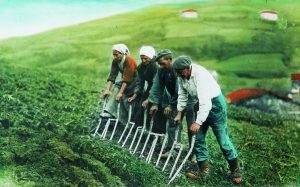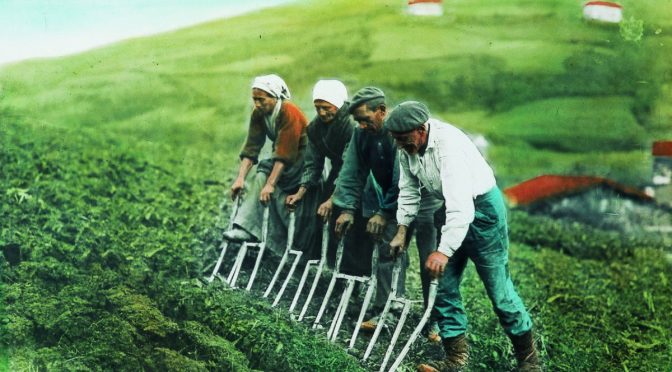If there is a defining trait of the Basques, it might be their work ethic, their willingness to do the hard jobs. That’s one reason they were such great sheepherders – they would go into the hills for months at a time, often with little experience, and just get the job done. Their propensity for hard work is even more remarkable when you consider the rough land they had to work at home, tilling the rugged earth almost by hand. Their primary tool – the laia – has become a defining symbol of that hard working life.

- The laia is a type of spade consisting of a long wooden handle and two prongs or teeth made out of metal, usually iron or steel. The handle effectively extends from one of the teeth, forming an ‘h’ shape. A person would first raise the laia above their head and then drive it into the ground. He or she would then push on the ledge of the ‘h’ to drive it further into the ground and then the push the handle down to turn the soil. One person would use two laia in this way, to more effectively work the land. A team of people would work together to till a complete a field. Neighbors would help neighbors, trading turns to till each other’s fields.
- The laia had an advantage over the plow for some areas in that it can be used to turn the soil deeper than a plow and is easier to use in places with an appreciable slope.
- In vineyards, they would also be used to make holes in which to plant vines.
- There are two main types of laia, adapted to the local land, though a near infinite variety exists. In Nafarroa, the handle is longer but the teeth are shorter (about one foot long) while in Bizkaia and Gipuzkoa, the laia tends to have longer prongs or teeth (about 2.5 feet long). This is because the ground is softer in the coastal provinces and thus longer teeth can penetrate the earth and aerate it better.
- In Olite, the entrance to the church, which was built in the 13th century, has an image of a man using the laia to till the soil. While we don’t know when the laia was first developed, this highlights that it isn’t a new tool.
- In the towns of Artajona and Puente la Reina, in Nafarroa, one way they are keeping the traditions of the laia are to hold races. The laia are used like mini-stilts – people step up on two laia and then, holding the relatively short handles in their hands, they race down the streets.
A full list of all of Buber’s Basque Facts of the Week can be found in the Archive.
Primary sources: Garmendia Larrañaga, Juan. laia. Auñamendi Encyclopedia, 2024. Available at: https://aunamendi.eusko-ikaskuntza.eus/en/laia/ar-151115/; Laya (herramienta), Wikipedia; Laia (nekazaritza), Wikipedia; Layas, Laiak, Atlas Etnográfico de Vasconia
Discover more from Buber's Basque Page
Subscribe to get the latest posts sent to your email.



Loved this!
Hahah I love the laia race footage! No idea this was a thing!